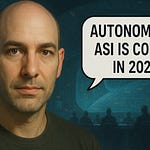Unstructured Thoughts about OpenAI o3, the nature of AGI, and Post-Labor Economics
AGI just crossed a threshold—here’s why that matters and what we can do with it.
I’ve been hammering on OpenAI’s new o3 model for a few days, long enough to watch the hype settle into something more interesting: utility. Benchmarks suggest a polite incremental bump; lived experience says we’ve entered a qualitatively different regime. o3 is the first model that feels faster than my ability to absorb its output. My brain—not the AI—has become the bottleneck.
A new ceiling for human cognition?
Most discussions of “alien intelligence” forget that we share the same sandbox: mathematics, physics, code, natural language. What shifts is cognitive horizon—the totality you can mentally represent and manipulate. o3 expands that horizon in real time. In an afternoon it consolidated two years of my work on post‑labor economics, stress‑tested the logic, surfaced data sources, and offered to autogenerate the Python notebooks. The cost of insight has collapsed from years to hours.
If you merely outsource thought, you’ll stagnate. If you treat the model as a sparring partner—interrogating, refining, iterating—you’ll compound your own intelligence. Exponential leverage is now a choice, not a privilege.
What o3 got right about my health project?
I dumped the entire history of my chronic‑fatigue recovery protocol—including the five‑axis “burnout pentagram”—into memory and asked the model where I’d gone astray. It corrected a handful of minor assumptions and, more importantly, recalibrated my timeline: six‑to‑eight months of recovery left instead of eighteen. That’s not “replace your doctor” advice; it’s proof that large‑context reasoning is finally clinically useful.
Post‑Labor Economics: the sketch that o3 and I built in one sitting
1. Metric 1 – Economic Agency Index (EAI)
Income decomposed into wages, property, and transfers. The higher the property share, the more “post‑labor” you already are.
2. Metric 2 – Collective Purchasing Power (CPP)
How much capital a county can mobilize without taxation or new debt. Rising CPP means you are compounding local prosperity.
Interventions happen at the county level (subsidiarity): solar co‑ops in Arizona, riverfront greenways in the Midwest, data‑center dividends in fiber‑rich exurbs. Ownership is local, revenue is distributed, migration equilibrates naturally, and environmental stewardship becomes self‑interest rather than moral theater. UBI morphs from last‑ditch transfer to one of several levers for raising EAI.
The bigger picture:
AGI isn’t an oracle descending from the sky; it’s a time‑compression engine. Every minute you spend learning how to learn with it buys you an hour you would have burned doing rote synthesis. The frontier question is no longer “Will the machines replace us?” but “How fast can we upgrade ourselves in partnership with them?”
What’s next?
I’m cleaning the data, building the national EAI/CPP dashboard, and pressure‑testing the whole framework. I’ll publish the notebooks (or let o3 do it) once the numbers are solid. Meanwhile, I want to hear from you:
Where does o3 add the most leverage in your world?
Which of the post‑labor metrics feels wrong—or dangerously right?
What failure mode should falsify this thesis?
Drop your critique, your data source, or your wild counter‑proposal in the comments. Let’s map the edge of this new cognitive horizon together.
—Dave










